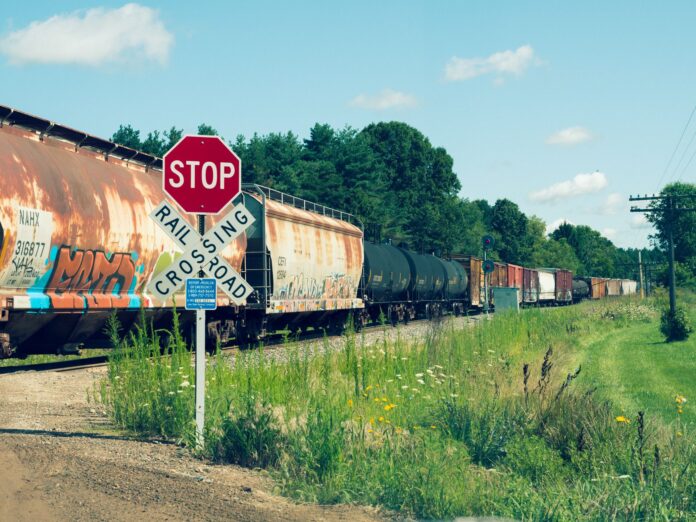by Topher Sanders and Dan Schwartz, ProPublica, and Joce Sterman, Gray Television/InvestigateTV; Video by Scotty Smith, Gray Television/InvestigateTV; Photography by Jamie Kelter Davis for ProPublica
This story was originally published by ProPublica. ProPublica is a Pulitzer Prize-winning investigative newsroom. Sign up for The Big Story newsletter to receive stories like this one in your inbox.
Series: Train Country
Investigating Railroad Safety in America
Jeremiah Johnson couldn’t convince his mother to let him wear a suit, so he insisted on wearing his striped tie and matching pocket square. It was picture day and the third grader wanted to get to school on time. But as he and his mom walked from their Hammond, Indiana, home on a cold, rainy fall morning, they confronted an obstacle they’d come to dread:
A sprawling train, parked in their path.
Lamira Samson, Jeremiah’s mother, faced a choice she said she has to make several times a week. They could walk around the train, perhaps a mile out of the way; she could keep her 8-year-old son home, as she sometimes does; or they could try to climb over the train, risking severe injury or death, to reach Hess Elementary School four blocks away.
She listened for the hum of an engine. Hearing none, she hurried to help Jeremiah climb a ladder onto the flat platform of a train car. Once up herself, she helped him scramble down the other side.
ProPublica and InvestigateTV witnessed dozens of students do the same in Hammond, climbing over, squeezing between and crawling under train cars with “Frozen” and “Space Jam” backpacks. An eighth grade girl waited 10 minutes before she made her move, nervously scrutinizing the gap between two cars. She’d seen plenty of trains start without warning. “I don’t want to get crushed,” she said.
Recent spectacular derailments have focused attention on train safety and whether the nation’s powerful rail companies are doing enough to protect the public — and whether federal regulators are doing enough to make them, especially as the companies build longer and longer trains.
But communities like Hammond routinely face a different set of risks foisted on them by those same train companies, which have long acted with impunity. Every day across America, their trains park in the middle of neighborhoods and major intersections, waiting to enter congested rail yards or for one crew to switch with another. They block crossings, sometimes for hours or days, disrupting life and endangering lives.
News accounts chronicle horror stories: Ambulances can’t reach patients before they die or get them to the hospital in time. Fire trucks can’t get through and house fires blazeout of control. Pedestrians trying to cut through trains have been disfigured, dismembered and killed; when one train abruptly began moving, an Iowa woman was dragged underneath until it stripped almost all of the skin from the back of her body; a Pennsylvania teenager lost her leg hopping between rail cars as she rushed home to get ready for prom.
In Hammond, the hulking trains of Norfolk Southern regularly force parents, kids and caretakers into an exhausting gamble: How much should they risk to get to school?
The trains, which can stretch across five or six intersections at a time in this working-class suburb of 77,000, prevent students and teachers from getting to school in the morning. Teachers must watch multiple classrooms while their colleagues wait at crossings; kids sit on school buses as they meander the streets of an entirely different city to be dropped off a half-hour late. Brandi Odom, a seventh grade teacher, estimates that at least half her class is delayed by trains multiple times a week.
The adults entrusted with their safety — parents and teachers, police and fire officials, the mayor — say they are well aware of the pressures on students’ minds when they face a blocked crossing on foot. They know some are hungry and don’t want to miss breakfast; the vast majority in this 86% Black and Latino district qualify for free or reduced-price meals at school. And they know that many of their parents commute to work an hour away to Chicago, trusting older brothers or sisters to pick up or drop off their siblings.
“I feel awful about it,” said Scott E. Miller, the superintendent. His district has asked Norfolk Southern for its schedule so that the schools can plan for blockages and students can adjust their routines. The company has disregarded the requests, school officials said.
Mayor Thomas McDermott Jr. said that his experience with the rails has been similar, and that company officials have reminded him the rails “were here first,” running through Hammond before it was even a city. “To them, I am nobody,” he said. “They don’t pay attention to me. They don’t respect me. They don’t care about the city of Hammond. They just do what they want.”
In written responses to questions, a spokesperson for Norfolk Southern said children climbing through their trains concerns the company.
“It is never safe for members of the public to try to cross the cars,” spokesperson Connor Spielmaker said. “We understand that a stopped train is frustrating, but trains can move at any time and with little warning — especially if you are far from the locomotive where the warning bell is sounded when a train starts.”
He said trains routinely sit in Hammond for a number of reasons: That section of track is between two busy train intersections that must remain open; Norfolk Southern can’t easily move a train backward or forward, because that would cut off the paths for other trains, which could belong to other companies. And Hammond is a suburb of Chicago, which is the busiest train hub in the nation, creating congestion up and down the network.
He said Norfolk Southern is working to identify an area where trains can stage further down its line and to have less impact on the community. The company will also review its procedures to see whether its trains can give louder warnings before they start moving. (ProPublica reporters witnessed trains in Hammond start moving without warning.) Spielmaker said that train schedules vary so much that giving Hammond one might not be helpful. He said that the company is in “constant communication” with local officials, and that representatives will discuss any proposed fixes with Hammond.
Rail companies around the country could better coordinate their schedules, parking trains far from schools that are in session. They could also build shorter trains that fit into railyards so their tail ends don’t block towns’ crossings. Hammond essentially serves as a parking lot for Norfolk Southern’s trains, creating a problem so pressing that Indiana plans to spend $14 million — about $10 million of which is coming from federal grants — to build an overpass for cars. The bridge won’t help many students, who would need to walk at least a mile out of their way just to reach it. Norfolk Southern, the multibillion-dollar corporation causing the problem, is contributing just $500,000 of the bridge’s cost, despite the city asking for more.
Norfolk Southern did not respond directly to questions about whether it should chip in more to the upcoming project, but the company said it contributes to many safety projects and maintains more than 1,600 grade crossings in Indiana alone. Read the company’s full response here.
On three separate occasions during the fall and winter, reporters witnessed Norfolk Southern trains blocking intersections leading to an elementary, a middle and a high school for four, six and seven hours. ProPublica and InvestigateTV showed footage of kids making the crossing, including an elementary student crawling under a train, to representatives of Norfolk Southern, lawmakers and Secretary of Transportation Pete Buttigieg, whose remit includes rail safety.
He was shocked.
“Nobody,” Buttigieg said, “can look at a video with a child having to climb over or under a railroad car to get to school and think that everything is OK.”
The video also stunned state officials who had long known about the problem. “That takes my breath away,” said Indiana state Rep. Carolyn Jackson, who represents the Hammond area and has filed a bill attempting to address blocked crossings every session for the past five years. None has ever gotten a hearing. “I hope that they will do something about it and we won’t have to wait until a parent has to bury their child.”
The blocked crossing problem is perennial, especially in cities like Hammond that are near large train yards. But in the era of precision scheduled railroading, a management philosophy that leans heavily on running longer trains, residents, first responders, rail workers and government leaders told ProPublica it is getting worse as trains stretch farther across more intersections and crossings. “The length of the long trains is 100% the cause of what’s going on across the country right now,” said Randy Fannon, a national vice president of the Brotherhood of Locomotive Engineers and Trainmen. “No engineer wants to block a crossing.”
The Federal Railroad Administration, the agency that regulates rail safety, started a public database in late 2019 for complaints about blocked crossings and fielded more than 28,000 reports of stopped trains last year alone. Among them were thousands of dispatches from 44 states about pedestrians, including kids, crossing trains. Someone in North Charleston, South Carolina, summarized the situation in three letters: “Wtf.”
A rail administration spokesperson said the agency shares the data monthly with companies. “When railroads fail to act quickly,” and if a crossing is reported as blocked three days in a calendar month, officials will contact a company to determine the cause and try to work out solutions, Warren Flatau said. “We are receiving various levels of cooperation … and welcome more consistent engagement.” Read more about what the agency says it is doing here.
Buttigieg said that this spring or summer, he expects to announce the first grants in a new U.S. Department of Transportation program designed to help alleviate blocked crossings. The federal government is putting $3 billion into the program over five years.
State lawmakers have tried to curb blocked crossings by restricting the lengths of trains. Since 2019, in Arkansas, Iowa, Kansas, Georgia, Nebraska, Virginia, Washington, Arizona and other states, lawmakers have proposed maximum lengths of 1.4 to about 1.6 miles. (There is no limit now, and trains have been known to stretch for 2 or more miles.) Every proposal has died before becoming law.
Opponents, including the nation’s largest railroad companies, claim that the efforts are driven by unions to create jobs and that the measures would violate interstate commerce laws. As ProPublica has reported, train length has been essential to creating record profits for rail companies in recent years.
The industry has also sued to block more modest measures. In Hammond, for instance, police used to be able to write tickets for about $150 every time they saw a train stalled at a crossing for more than five minutes. Instead of paying the individual citations, Hammond officials told ProPublica, Norfolk Southern would bundle them and negotiate a lower payment.
“We weren’t getting anything,” McDermott, the mayor, said, “but it made our residents feel good.” An Indiana court took the industry’s side — as many courts in other states have done — ruling that only the federal government held power over the rails. “We can’t even write tickets anymore,” the mayor said. “It was more of an illusion, and we can’t even play the illusion anymore.”
He said the blockages have forced Hammond to keep more firefighters and stations than would normally be needed for a city its size. “I have to have a firehouse fully staffed on both sides of the rail line so that we can respond in a timely manner to an emergency, which is very expensive,” McDermott said.
The problem has become so endemic in Hammond that getting “trained,” or stalled at crossings, has become a verb.
Police officers are delayed several times a day, said Hammond Police Department spokesperson Lt. Steve Kellogg. Last October, an officer couldn’t get backup as he confronted a man who was holding a knife, bleeding and not responding to commands. The officer pulled his weapon and the man ultimately cooperated, but someone could have died, Kellogg said. Hammond’s powerlessness over the rails is frustrating, he added. “They’re all controlled by the feds, and they do whatever the hell they want to do.”
Spielmaker, the Norfolk Southern spokesperson, said: “We work with first responders on a daily basis to assist however we can. For example, there was a situation in Georgia where a train was stopped on a crossing due to a broken down train ahead. The train could not be moved, so we worked with the first responders to make sure the train was safe for them to maneuver through with it in place.”
In his 24 years fighting fires in Hammond, Mike Hull, president of a local union, said not once has he seen railroads do that for first responders. “They’ve never come back and said, ‘We’re going to move this train for you,’” he said.
State and local officials grew hopeful on March 20 when the U.S. Supreme Court invited the federal government to comment on a petition from Ohio seeking the authority to regulate how long a train can block a crossing. The high court will likely hear the case if the solicitor general recommends it, said Tom Goldstein, publisher of SCOTUSblog, which is widely seen as an authority on the court. Nineteen other states have signaled their support for a Supreme Court case. Goldstein expects the solicitor general to respond in November or early December. A favorable court opinion could allow other states to finally enforce their laws on blocked crossings.
In the meantime, Buttigieg believes federal lawmakers must intervene to give the Federal Railroad Administration the power to compel rail companies to keep crossings clear. This time of intense public interest in railroads has opened a window for action, Buttigieg said, but it is fleeting. “Any moment that the public attention starts to fade, the railroads are then once again in a position to assert themselves in Washington and to ignore some of the phone calls they are getting in the communities,” he said.
Buttigieg said his staff is ready to participate in a federal hearing in which it can tell lawmakers what new authorities they would need to regulate blocked crossings.
U.S. Rep. Sylvia Garcia, D-Texas, said she is eager for new law. A fire chief in her district, which covers parts of the Houston area, told her the department has had to detour 3,200 times since 2019 because of blocked crossings. She and other congressional Democrats introduced the Don’t Block Our Communities Act in early March, but it has not yet gained bipartisan traction. The proposed law would prohibit rail companies from blocking crossings for more than 10 minutes and would allow the rail administration to fine companies for repeated violations.
Like the other officials, Garcia said she was aghast, but not surprised, about the situation in Hammond. “That is outrageous, look at the little bitty baby,” she said while watching a video of a young girl crawling under a train car. “That’s what I mean about making sure we do more to protect the safety of our children. That happens too in Houston.”
In Hammond, a public meeting is scheduled for Wednesday at 5:30 p.m. at Scott Middle School to discuss the overpass project. Among those who hope to voice their concerns about the blocked crossings are rail workers themselves who worry about the kids. “It’s just a matter of time until there is a catastrophic incident,” said Kenny Edwards, the Indiana legislative director for the nation’s largest rail union.
Efrain Valdez, president of the parent teacher association, said he hopes officials can adjust plans to help students who need to walk to school. “To see our children in danger like that, that’s just downright crazy,” he said. “I’m just appalled and heartbroken that [the railroad] would think that’s OK. That their money means more to them than a child’s life.”
Until there’s a better solution, the ritual continues. Some parents act as de facto crossing guards, standing beside trains to help their children and others cross. Others ask their kids to call them before and after they make the climb, while warning them about the worst that can happen.
Rudy Costello tells his daughter, who is in high school, to be careful, because if the train moves she “could slip and then there goes your leg and your foot. Or you get pulled under the train and there goes you all together.” He added: “That’s been my biggest fear, her foot slipping off. … But what can you do? Because those trains are always stopping over there, for hours.”
Akicia Henderson said she has tried to avoid making the dangerous climb with her 10-year-old daughter. “I called a Lyft,” she said. “The Lyft driver actually canceled on me twice because he couldn’t get around the train.”
So she walks toward the tracks, picturing all that can go wrong — a jacket snags, a backpack tangles, the wheels begin to turn. She prays that this will be one of the days their path isn’t blocked and that she doesn’t hear the sound she has most come to fear, a horn in the distance.
“It’s like, ‘Oh my God, the train is coming.’”
Image: Chris Bair/Unsplash



































